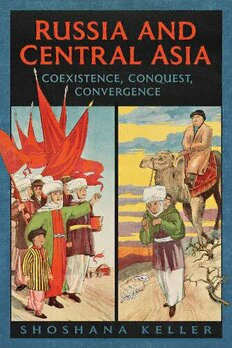
Russia and Central Asia: Coexistence, Conquest, Convergence PDF
Preview Russia and Central Asia: Coexistence, Conquest, Convergence
RUSSIA AND CENTRAL ASIA Russia and C entral Asia Coexistence, Conquest, Convergence Shoshana Keller UNIVERSITY OF TORONTO PRESS Toronto Buffalo London © University of Toronto Press 2020 Toronto Buffalo London utorontopress.com Printed in Canada All rights reserved. The use of any part of this publication reproduced, transmitted in any form or by any means, electronic, mechanical, photocopying, recording, or otherwise, or stored in a retrieval system, without prior written consent of the publisher—or in the case of photocopying, a licence from Access Copyright (the Canadian Copyright Licensing Agency), 320–56 Wellesley Street West, Toronto, Ontario, M5S 2S3—is an infringement of the copyright law. Library and Archives Canada Cataloguing in Publication Title: Russia and Central Asia : coexistence, conquest, convergence / Shoshana Keller. Names: Keller, Shoshana, author. Description: Includes bibliographical references and index. Identifiers: Canadiana 20190187271 | ISBN 9781487594350 (hardcover) | ISBN 9781487594343 (softcover) Subjects: LCSH: Russia (Federation)—Relations—Asia, Central—History. | LCSH: Asia, Central—Relations—Russia (Federation)—History. Classification: LCC DK857.75.R8 K45 2020 | DDC 303.48/247058—dc23 We welcome comments and suggestions regarding any aspect of our publications—please feel free to contact us at [email protected] or visit our internet site at utorontopress.com. North America UK, Ireland, and continental Europe 5201 Dufferin Street NBN International North York, Ontario, Canada, M3H 5T8 Estover Road, Plymouth, PL6 7PY, UK orders phone: 44 (0) 1752 202301 2250 Military Road orders fax: 44 (0) 1752 202333 Tonawanda, New York, USA, 14150 orders e-mail: [email protected] orders phone: 1–800–565–9523 orders fax: 1–800–221–9985 orders e-mail: [email protected] Every effort has been made to contact copyright holders; in the event of an error or omission, please notify the publisher. Printed on acid-free paper. University of Toronto Press acknowledges the financial assistance to its publishing program of the Canada Council for the Arts and the Ontario Arts Council, an agency of the Government of Ontario. CONTENTS Acknowledgments vii A Note on Spelling ix Place Names xi Introduction 1 chapter 1 Early Coexistence 21 chapter 2 The Balance of Power Shifts 45 chapter 3 Conquest 81 chapter 4 Imperial Rule 109 chapter 5 Revolutions 133 chapter 6 Founding Soviet Central Asia 157 chapter 7 Breaking and Building—The Stalin Era 179 chapter 8 Stability and Growth 211 chapter 9 From Reform to Independence 235 Notes 259 Glossary 309 Bibliography 313 Index 341 ACKNOWLEDGMENTS I owe a great deal to my colleagues in the field and at Hamilton College for their deep knowledge and generosity. At Hamilton, thanks to Kevin Grant, Lisa Trivedi, Bonnie Urciuoli, Chaise Ladousa, Nathan Goodale, and Sally Cockburn for their careful reading, comments, and help with anthropologi- cal theory and Venn diagrams. Scott C. Levi, Gulnara Kendirbai, Alisher Khaliyarov, Alexander Morrison, Sarah Cameron, Marianne Kamp, Russell Zanca, R. Charles Weller, Erika Monahan, and the two anonymous reviewers contributed their scholarship and advice to make this a better book, although all mistakes are my responsibility. The maps were made by Bill Nelson at Bill Nelson – Cartography. My spouse, Deborah Reichler, gets my deepest gratitude for everything. A NOTE ON SPELLING It is a truth universally acknowledged in Central Asian studies that spelling is a nightmare. The languages of Central Asia have been written in multiple versions of the Perso-Arabic, Latin, and Cyrillic alphabets. Almost thirty years after the end of the Soviet Union, Uzbekistan, Turkmenistan, and Kazakhstan each use mixed, and still evolving, Latin and Cyrillic alphabets while Kyrgyzstan and Tajikistan use different Cyrillic alphabets. In class I tell my students that any spelling that is recognizably “in the ballpark” will do. That standard, of course, will not do here. I use the Library of Congress system for transliterating from Russian. For Central Asian languages I have opted to use the American standard or most accessible spelling available, rather than the most historically accurate. Hence “Kazakh” as the standard rendering of “Qozoq”; “Kyrgyz” for what could be written as “Kirghiz,” “Kirgiz,” or “Qyrgyz”; and “Kokand” for the city that is spelled “Khoqand” in pre-Soviet manuscripts and “Qo’qon” in Uzbekistan’s current Latin alpha- bet. An exception is made for the fact that, until 1925, Russians called the Kazakhs “Kirgiz,” and the Kyrgyz “Kara-Kirgiz” (Black Kirgiz). In this case I transliterate “Kirgiz” from the Russian to indicate the old nomenclature. For Uzbek words and names I use the current Uzbek Latin alphabet. There are a few letters that need explanation: G’ a voiced glottal “gh,” as in clearing one’s throat J American pronunciation, as in “July” Q a glottal hard “k” sound O’ a short “u,” similar to the German “ö” X p ronounced as the Yiddish “ch” in “chutzpah”; written as “Kh” from the Cyrillic
